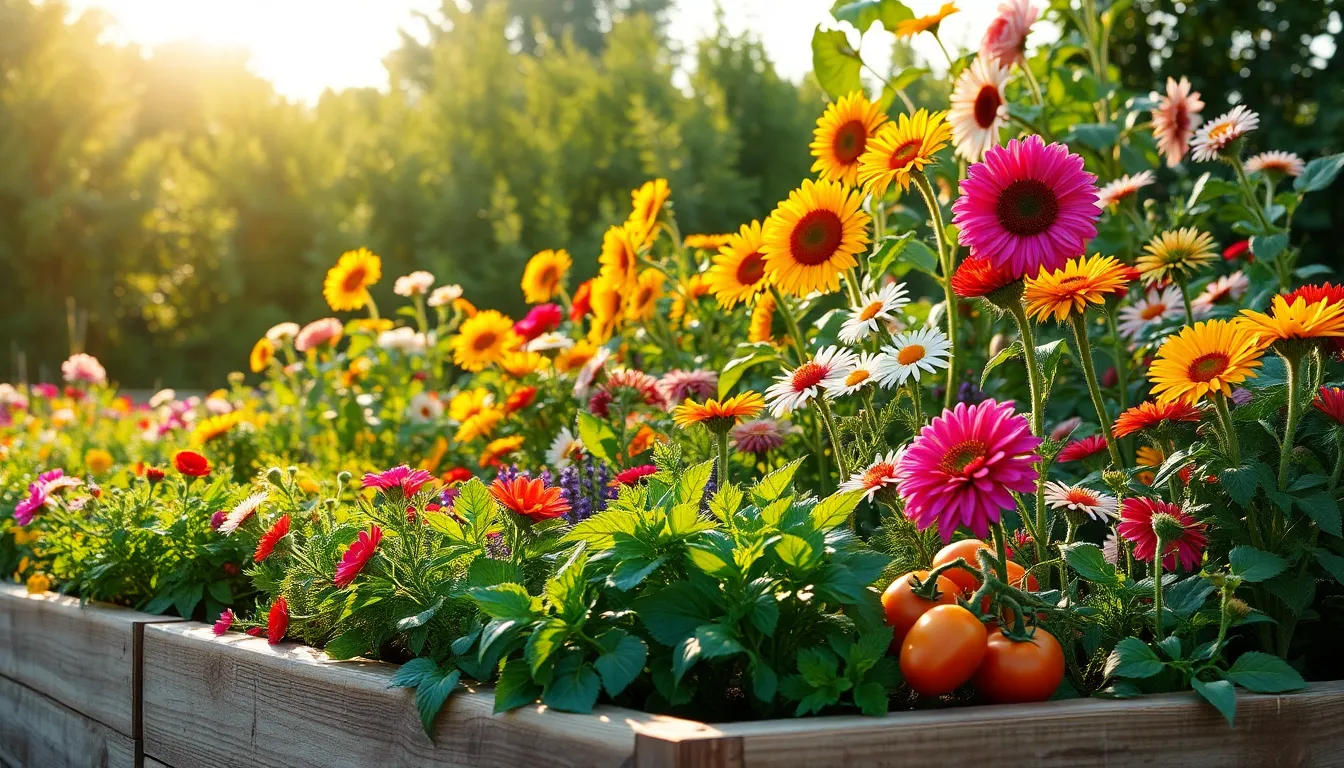Gardens are like a buffet for the soul, offering a delicious array of styles and vibes to suit every taste. Whether someone dreams of a tranquil Zen retreat or a vibrant cottage bursting with color, there’s a garden type that’ll tickle their fancy. With so many options, it’s easy to get lost in the lush greenery and vibrant blooms, but fear not—this guide will help navigate the garden maze.
Garden Types
Garden types fall into various categories, each bringing unique characteristics and benefits. For example, vegetable gardens focus on growing edible plants, making them practical for those looking for fresh produce. Flower gardens, on the other hand, emphasize aesthetics with colorful blooms that attract pollinators.
Landscape gardens highlight the natural beauty of the environment; these gardens often feature tree varieties and shrubs that enhance outdoor spaces. Cottage gardens blend flowers and vegetables in a charming, informal arrangement, offering both beauty and functionality.
Zen gardens inspire tranquility and meditation through minimalistic design, often incorporating rocks, sand, and gravel to symbolize water and create a sense of peace. Rock gardens utilize stones and alpine plants, showcasing natural terrains and providing excellent drainage for plants.
Herb gardens cater to culinary enthusiasts, offering fresh herbs like basil and rosemary close at hand. Water gardens, filled with aquatic plants and fish, introduce a serene element to any space, promoting relaxation and enjoyment of nature.
Tropical gardens present lush greenery and vibrant flowers, mimicking the humid climates of tropical regions. Roof gardens maximize space, bringing greenery to urban settings while improving insulation and air quality.
Overall, selecting a garden type hinges on personal interests, available space, and climate conditions. Each style presents opportunities for creativity and expression, enhancing environments and contributing to overall well-being.
Formal Gardens

Formal gardens present an elegant and structured approach to landscaping. They feature geometric designs, symmetry, and carefully planned layouts that create an aesthetic appeal.
Characteristics of Formal Gardens
Structured layouts define formal gardens, where precision in design plays a key role. Symmetry often governs plant arrangements, establishing balance and order. Pathways constructed of gravel or stone direct visitors through the space. Focal points such as statues or fountains draw attention, enhancing visual interest. Pruned hedges and topiaries maintain a tidy appearance, reinforcing the meticulous nature of this garden type. Seasonal flower displays offer vibrant colors, contributing to the overall beauty throughout the year.
Popular Styles of Formal Gardens
Italian Renaissance gardens embody elegance with features like terraces and water elements. French formal gardens, known as jardins à la française, emphasize symmetry and intricate geometric patterns. English formal gardens often blend with natural scenery, creating a refined yet harmonious look. Persian gardens introduce symmetrical layouts focused on water channels symbolizing paradise. Baroque gardens showcase dramatic designs with grand staircases and ornate sculptures, elevating the overall experience. Each style offers unique elements that highlight artistry and meticulous planning in landscaping.
Informal Gardens
Informal gardens provide a relaxed and inviting atmosphere, prioritizing natural beauty and spontaneity. They often blend various plants and materials, creating a harmonious and organic space.
Features of Informal Gardens
Natural shapes define informal gardens. Curved pathways and asymmetrical plant arrangements enhance visual appeal. A wide variety of plant species—including perennials, annuals, and wildflowers—contribute to biodiversity. Colorful blooms attract pollinators, fostering an ecosystem. Elements such as rustic furniture, boulders, and water features add character and charm. Seasonal changes infuse vibrancy, maintaining interest throughout the year.
Examples of Informal Garden Styles
Cottage gardens typically feature mixed borders with herbs, flowers, and vegetables. These gardens celebrate a vibrant palette and intertwining growth. Wildlife gardens prioritize native plants and habitats, promoting ecological balance. Woodland gardens thrive in shaded areas with ferns and groundcovers, embracing a forest-like feel. Xeriscapes, designed for arid regions, utilize drought-resistant plants, showcasing sustainable practices. Each style emphasizes lushness and individuality, inviting exploration and relaxation.
Vegetable Gardens
Vegetable gardens provide a practical and rewarding way to cultivate fresh produce at home. They encourage healthier eating habits while offering satisfaction and engagement through gardening.
Benefits of Growing Vegetables
Growing vegetables enhances physical health by increasing access to fresh, nutritious food. Homegrown produce often contains higher levels of vitamins compared to store-bought options. Additionally, cultivating a vegetable garden fosters mental well-being by providing a calming outdoor activity. Engaging with nature lowers stress levels and promotes mindfulness. Cost savings also come into play, as growing one’s own vegetables reduces grocery expenses. Sustainability benefits arise from lower carbon footprints, as home gardens decrease the need for transportation. Gardening connects individuals with their food and encourages informed choices.
Types of Vegetable Gardens
Various types of vegetable gardens cater to different preferences and requirements. Raised bed gardens elevate soil for improved drainage, making them accessible while allowing for soil control. Container gardens utilize pots or boxes, ideal for small spaces or urban settings. Square foot gardens maximize productivity by dividing garden areas into smaller sections for intensive planting. Hydroponic gardens grow vegetables without soil, using nutrient-rich water, suitable for limited spaces indoors. Vertical gardens efficiently use vertical space, employing trellises or towers for climbing plants. Each type presents unique advantages, allowing gardeners to choose based on their available space and gardening goals.
Flower Gardens
Flower gardens focus on creating a vibrant and aesthetically pleasing environment. These gardens attract pollinators and bring joy with their colorful blooms.
Choosing the Right Flowers
Selecting flowers depends on the garden’s location, climate, and personal preference. Consider hardy perennials like lavender and coneflower for longevity. Annuals such as marigolds and petunias offer continuous blooms throughout the season. Native plants often thrive best in local conditions, supporting biodiversity. Grouping flowers with similar water and sunlight needs simplifies care. It’s essential to consider bloom time for a succession of colors. Incorporating different heights creates visual interest, with taller plants at the back and shorter ones in front. Selecting a mix of textures and colors enhances the garden’s beauty successfully.
Maintenance Tips for Flower Gardens
Proper maintenance ensures flower gardens remain healthy and vibrant. Regular watering is crucial, particularly during dry spells. Pruning dead blooms promotes new growth and extended flowering. Applying mulch retains soil moisture and suppresses weeds effectively. Fertilizing with a balanced mix supports healthy development. Pests may sometimes require attention; monitoring plants regularly helps catch issues early. Recognizing the signs of disease also maintains garden health. Seasonal clean-up, including removing debris, prepares gardens for new growth. Consistent care fosters a flourishing and inviting flower garden.
Conclusion
Choosing the right garden type can transform any outdoor space into a personal sanctuary. Each style offers distinct benefits and caters to various interests and needs. Whether one prefers the structured elegance of formal gardens or the relaxed charm of informal ones, there’s a perfect fit for everyone.
Exploring the diversity of gardens allows individuals to express creativity while enhancing their well-being. With the right knowledge and inspiration, anyone can cultivate a garden that reflects their personality and lifestyle. Embracing the journey of gardening not only nurtures plants but also fosters a deeper connection with nature.

